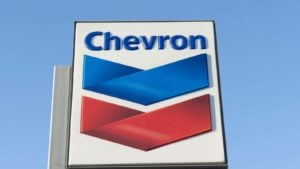- Cheniere Energy (LNG): Liquified natural gas (LNG) production expectations and rapidly improving guidance make Cheniere Energy buy-worthy.
- Chevron (CVX): Chevron looks to reward its shareholders with a strong buyback plan based on increasing cash flow expectations.
- DCP Midstream (DCP): LNG firm already expected blowout income growth to begin in 2022, making it even stronger on geopolitical tensions.
There is a lot going on in the energy sector. The Russian invasion of Ukraine and the ongoing war are playing a big role in the overall narrative. But investors should note that the strong performance of the energy sector isn’t solely related to the war and its effects.
The truth is that the energy sector was the strongest industrial component of the S&P 500 in 2021. The sector returned 53.3% as measured by the indexes that track the respective sectors.
2022 has started out on a similar foot: The energy sector has increased by 38.8% according to a recent report by Yardeni Research. Of the 13 sectors tracked, only 2 others, consumer staples and utilities, have provided any returns at all. But their respective returns of 1.8% and 6% lag far behind the 38.8% returns from the energy sector.
That clearly suggests that energy stocks ought to be on investor buy lists this month. The S&P 500 is down year-to-date, but energy stocks are a bright spot within the market. There are lots of potential plays out in the market currently. But let’s look at particularly strong stocks to consider.
| LNG | Cheniere Energy, Inc. | $138.56 |
| CVX | Chevron Corporation | $170.65 |
| DCP | DCP Midstream, LP | $35.08 |
Energy Stocks for April: Cheniere Energy (LNG)

Cheniere Energy (NYSEAMERICAN:LNG) won’t release earnings until May 4, but there are several reasons to believe that they will be strong. If that comes to pass, that should benefit its stock. The Houston-based energy firm primarily engages in the liquid natural gas sector as you likely guessed by its ticker.
Back to those catalysts. Back in late March, the U.S. and the EU agreed to work together to reduce EU reliance upon Russia for LNG supply. The two powers want to reduce Russia’s energy reserves as a revenue source funding the ongoing war. As part of that deal, the U.S. agreed to provide at least 15 billion cubic meters of additional liquified natural gas to Europe in 2022.
Even before the outbreak of war in Ukraine, LNG was on pace to become increasingly important domestically, benefiting U.S. firms including Cheniere Energy. Back in January the Journal of Petroleum Technology was predicting that the U.S. would lead the world in LNG export capacity by the end of 2022.
Cheniere Energy rebounded strongly in 2021 coming off the pandemic lows of 2020. But investors should be keenly focusing on the firm’s revised 2022 EBITDA guidance figures in particular. The firm raised them from a range of $5.8-$6.3 billion to $7.0-$7.5 billion when it released its most recent earnings.
Chevron (CVX)

The bullish case for Chevron (NYSE:CVX) stock relies on gas and diesel prices that remain high. The national average price for a gallon of regular gas sits at $4.098 as I write this, with diesel costing $5.135. Those prices are down from a week ago, but up from a month earlier. Either way, Chevron is sitting in a strong position.
But even without current tailwinds, there are reasons to consider Chevron. The company is expecting operating cash flow per share to grow 10% annually at $60 per barrel brent. Brent crude oil prices sit at $104.19 today, implying that the short term may be even better.
Further, Chevron is committed to increasing share buyback percentage throughout 2022. The company raised its share buyback guidance range to between $5 to $10 billion, up from $3 billion to $5 billion at the beginning of March.
Energy Stocks for April: DCP Midstream (DCP)

DCP Midstream (NYSE:DCP) stock represents a midstream natural gas firm based in Denver. The firm processes, transports, and stores natural gas through pipelines that stretch across Colorado, Kansas, Oklahoma, New Mexico, Texas and Louisiana.
The company doesn’t release much news that could tell investors that production is rising so we can’t tell much about current tailwinds. However, DCP Partners saw a massive spike in net income in 2021. The firm reported $391 million in net income in the year following a $306 million net loss in 2020. That type of turnaround was true of many energy firms. But investors should be particularly interested in DCP Midstream because it forecast that it anticipates between $615-$765 million in net income this year.
That guidance was given back in early February before any of the Russia Ukraine issues began. The U.S. is already increasing LNG production because of that, which suggests that guidance could be exceeded. Further, DCP stock has strong analyst backing, with 10 of 12 analysts with coverage rating the shares a buy.
On the date of publication, Alex Sirois did not have (either directly or indirectly) any positions in the securities mentioned in this article. The opinions expressed in this article are those of the writer, subject to the InvestorPlace.com Publishing Guidelines.
